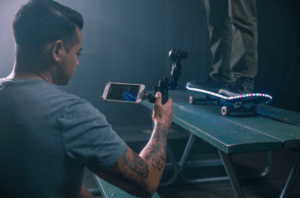 DJI is simply not going to sit still. Yesterday, the Shenzhen based leader in drone technology, released advanced imaging solutions for both consumers and professionals.
DJI is simply not going to sit still. Yesterday, the Shenzhen based leader in drone technology, released advanced imaging solutions for both consumers and professionals.
On the “low” end, DJI released announced it will offer its Micro Four-Thirds Zenmuse X5R camera for use with the Osmo, the imaging stabilization system. They call the new system the Osmo RAW which uses the same technology DJI launched last month on the Inspire 1 RAW aerial to bring cinematic-quality stabilized video to their drone.
The Osmo is a handheld camera with image stabilization stick that allows users to film action shots without any vibration (You can view DJI’s promotional video here).
The improved camera, the X5R, will attach to the Osmo handle via an adaptor and store video on a removable 512GB solid-state drive. Gimbal motors will ensure image stability on three axes, with pan and tilt functions accessible either by using the Osmo’s thumb stick or through the DJI GO app. Users can also control the X5R’s focus and aperture inside the iOS or Android app or using an optional DJI Focus unit.
DJI describes the X5R as “the world’s smallest, lossless 4K camera optimized for aerial imaging. It has 12.8 stops of dynamic range, an ISO range from 100 to 25,600, and a still-image resolution of 16 megapixels. The X5R features interchangeable lens options, with video bitrates averaging 1.7Gbps, with a maximum of 2.4Gbps. The X5R records CinemaDNG files and offers a new D-LOG mode with a broader array of color correction options in post production.” If that is all more than you need you could opt for the Micro Four-Thirds X5 camera and gimbal, called the Osmo Pro. It uses the same adaptor as the X5R, providing superior, stabilized video and top-quality photo imagery.
DJI has said that pricing and availability of the Osmo Pro and Osmo RAW will be announced shortly.

But the announcements did not end there. DJI also announced yesterday the Matrice 600, its next-generation aerial platform for professional aerial photography, filmmaking and industrial applications. Key features include:
- integration of DJI’s A3 flight controller onboard including Lightbridge 2 video-transmission technology offering high frame rates and HD live-streaming capability at distances up to five kilometers
- a six-rotor system with a maximum payload of 6.0 kilograms, compatible with the full range of DJI’s Zenmuse gimbals, including the Z15 series and the Zenmuse X series cameras
- a carrying weight that allows it to fly the Ronin MX, DJI’s newest handheld and aerial three-axis gimbal
- a dustproof propulsion system to simplify maintenance and increase durability
- actively cooled motors for more-reliable flight
- retractable landing gear for full 360-degree, unobstructed imaging.
The unit is powered by six DJI Intelligent Batteries which be turned on and off with the push of one button and keep the system aloft, should a single battery fail. The M600 will fly up to 36 minutes with a Zenmuse X5 camera attached and up to 16 minutes with a larger camera, such as a RED EPIC. Though it should be noted that flight time will vary for different cameras, gimbals and a number of other conditions.
The M600 supports the DJI GO app, which includes a live video feed, battery and redundancy status, transmission strength and other data to keep the user informed of flight status at all times. The app provides access to aperture, shutter speed, photo and video capture on any Zenmuse X-series camera, plus remote focus on the Zenmuse X5 and X5R cameras. However, you can also develop apps using the DJI Onboard Software Development Kit and Mobile SDK. It has dual parallel CAN and API ports for connecting DJI devices, including the Guidance sensor system, RTK GPS units or third-party components.
The M600’s retail price, including the integrated A3 flight controller with Lightbridge 2 and a full set of batteries, is $4,599.
Lastly, the M600 works seamlessly with Ronin-MX to offer three-axis aerial video stabilization.
“For film directors, the M600 is a game-changer. There are other options out there, but none that integrate a top-class flight controller, video-transmission system like Lightbridge 2 and support for a wide range of cameras and gimbals,” said DJI Executive Creative Director Sheldon Schwartz. “If you go with the new Ronin-MX on the M600, you’ll be surprised at how easy it is to get unparalleled stability and cinematic-quality shots.”
Mounted on the M600, the Ronin-MX’s CANBUS port allows all flight controller data to pass through to the Ronin-MX, meaning the gimbal is positionally aware and able to keep the horizon level. The Ronin-MX can pan 360 degrees, tilt +45 to -135 degrees and has redundant slip rings, offering enhanced reliability for operators. With an optional accessory, the Ronin-MX can transmit video real-time from a mounted camera, making full use of the M600’s Lightbridge 2 capabilities. It will also be compatible with the DJI Focus, through a wireless adapter mounted to the Focus remote.
The Ronin MX is compatible with a wide range of cameras from Arri, Black Magic, Canon, Panasonic, RED, Sony and Nikon. Its maximum load weight is around 4.5 kilograms.
The Ronin MX retails for $1,599. Bundled with the M600 and integrated A3 flight controller and Lightbridge 2, it will sell for $5,999.
Frank Schroth is editor in chief of DroneLife, the authoritative source for news and analysis on the drone industry: it’s people, products, trends, and events.
Email Frank
TWITTER:@fschroth







nice toy 🙂